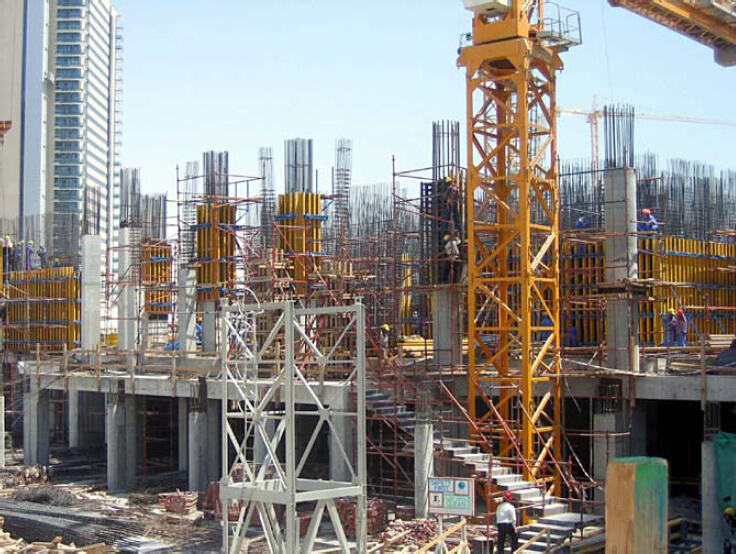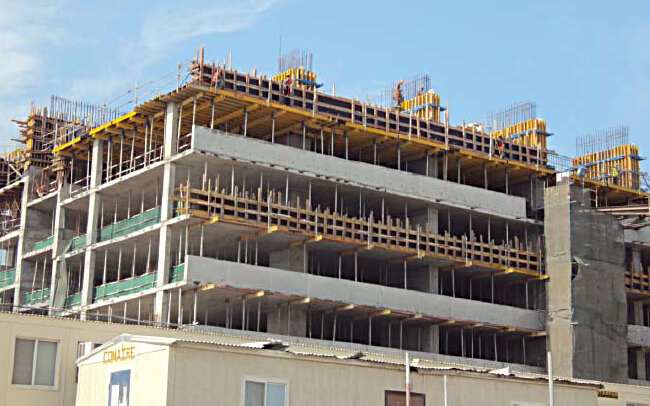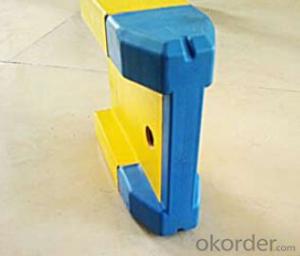Timber-beam Formwork for building Construction
- Loading Port:
- Tianjin
- Payment Terms:
- TT OR LC
- Min Order Qty:
- 50 m²
- Supply Capability:
- 1000 m²/month
OKorder Service Pledge
Quality Product, Order Online Tracking, Timely Delivery
OKorder Financial Service
Credit Rating, Credit Services, Credit Purchasing
You Might Also Like
Characteristics:
◆ Standardized production lines.
Supply capability: 3000m/day, Lmax = 6600mm.
◆ Finger jointing of the flange and web, the strength of timber beam is highly improved.
Max. shearing force failure load:40KN
◆ Well treated to prevent from water penetration or erosion, so the service life maximally
extended.
Normally, CNBM timber beam H20 can be used for 4 to 5 years, the exact using time would
depend on maintenance & storage.
◆ Robust caps at the end of the girders protect against damages.


- Q:How is steel formwork cleaned and maintained?
- Due to its durability and reusability, steel formwork is commonly utilized in construction projects. To maintain its quality and ensure its long lifespan, it is crucial to perform regular cleaning and maintenance. Here are some guidelines for cleaning and maintaining steel formwork: 1. Eliminate concrete residue: After each usage, it is necessary to remove any concrete residue from the steel formwork. This can be accomplished by chipping away the hardened concrete with a hammer or chisel, being careful not to damage the formwork surface. 2. Utilize power washing: Once the larger pieces of concrete have been removed, a high-pressure water jet can be used for power washing. This will help dislodge any remaining concrete particles and dirt from the formwork surface. While power washing, it is important to observe appropriate safety measures such as wearing protective clothing and goggles. 3. Apply chemical cleaning: If stubborn stains or concrete deposits cannot be removed through power washing alone, a chemical cleaning solution can be employed. There are various concrete removers available in the market that can be applied to the formwork surface. It is essential to follow the manufacturer's instructions for proper usage and safety precautions. 4. Remove and prevent rust: Steel formwork is prone to rusting, which can compromise its structural integrity. Regularly inspect the formwork for any signs of rust and eliminate it using wire brushes or sandpaper. After rust removal, apply a rust-inhibiting primer or a protective coating to prevent further rusting. This should be done prior to storing the formwork to ensure its preservation. 5. Store properly: When not in use, it is important to store steel formwork in a clean and dry environment. Exposure to moisture, extreme temperatures, and corrosive substances should be avoided, as these can negatively impact the formwork's quality. Proper stacking and organization can also prevent damage and deformation during storage. Regular maintenance and cleaning are vital for the longevity and reusability of steel formwork. By adhering to these steps and taking necessary precautions during cleaning and storage, steel formwork can be preserved in optimal condition for future construction projects.
- Q:Can steel formwork be used for projects with limited formwork budget?
- Indeed, projects with a limited formwork budget can make use of steel formwork. Steel formwork proves to be a cost-effective choice for construction projects due to its reusability, which in turn reduces the overall cost of formwork. Moreover, its durability and ability to withstand high pressure and heavy loads make it appropriate for a range of project types. Furthermore, steel formwork grants concrete structures a polished appearance, eliminating the requirement for supplementary finishing work. Consequently, utilizing steel formwork can be seen as a practical answer for projects with a restricted formwork budget, as it delivers long-term cost savings and enhances efficiency.
- Q:Can steel formwork be used for curved walls?
- Curved walls can indeed be constructed using steel formwork. With its flexibility and strength, steel formwork proves to be an ideal choice for shaping curved structures. By effortlessly bending and contouring the steel panels, the desired curvature of the wall can be achieved. Moreover, the use of steel formwork guarantees exceptional concrete support, as it ensures the curved wall retains its shape throughout the pouring and curing stages. However, it should be emphasized that constructing curved walls with steel formwork may necessitate specialized knowledge and expertise in design and construction.
- Q:How does steel formwork handle different concrete curing methods?
- Steel formwork is known for its durability and flexibility, which makes it suitable for handling different concrete curing methods. The strength and stability of steel formwork enable it to withstand the pressure exerted by different curing methods, ensuring that the formwork remains intact throughout the process. One common concrete curing method is the traditional wet curing method, where the concrete is kept moist by covering it with plastic sheets or wet burlap. Steel formwork can easily accommodate this method as it is non-absorbent and resistant to moisture. It effectively prevents water from seeping into the formwork, ensuring its longevity and structural integrity. Another curing method is the use of curing compounds or curing membranes that are applied to the concrete surface. These compounds create a barrier that prevents the moisture from evaporating too quickly, allowing the concrete to cure at a controlled pace. Steel formwork is compatible with curing compounds and membranes, as they can be easily applied and adhered to the surface of the formwork without causing any damage. Additionally, steel formwork can also handle the use of accelerated curing methods, such as the application of heat or steam to speed up the curing process. The high strength and heat resistance of steel allow it to withstand the elevated temperatures generated during accelerated curing without warping or deforming. This ensures that the formwork maintains its shape and stability, even under extreme conditions. In summary, steel formwork is well-suited to handle different concrete curing methods due to its durability, moisture resistance, and heat resistance. Its ability to withstand the pressures and conditions associated with various curing techniques makes it a reliable choice for construction projects that require versatile and robust formwork systems.
- Q:Can steel formwork be used for industrial construction projects?
- Yes, steel formwork can be used for industrial construction projects. Steel formwork offers several advantages such as durability, strength, and reusability, making it suitable for heavy-duty applications in industrial construction. It provides a stable and rigid structure to support concrete during the casting process, ensuring accurate and high-quality results. Additionally, steel formwork can withstand harsh weather conditions and repetitive use, making it ideal for industrial projects that require long-term and reliable formwork systems.
- Q:Can steel formwork be used for both straight and curved concrete elements?
- Steel formwork is suitable for both straight and curved concrete elements. Its versatility allows for easy adjustment and shaping to meet various design needs. With its excellent strength and durability, steel formwork is perfect for constructing both straight and curved elements. Its flexibility allows for the creation of complex shapes, making it ideal for projects that require curved elements like architectural features, curved walls, or circular structures. Furthermore, steel formwork ensures a smooth and uniform surface finish, guaranteeing high-quality concrete results for both straight and curved elements.
- Q:Can steel formwork be used for structures with high seismic resistance requirements?
- Yes, steel formwork can be used for structures with high seismic resistance requirements. Steel formwork is known for its strength, durability, and stability, which makes it suitable for withstanding seismic forces. It provides a rigid framework that can withstand lateral forces and vibrations caused by earthquakes. Steel formwork offers several advantages for structures with high seismic resistance requirements. Firstly, it provides a sturdy and reliable support system during the construction process, allowing for accurate placement and alignment of reinforcement and concrete. This ensures that the structural elements are properly connected and reinforced, enhancing the overall seismic performance of the structure. Additionally, steel formwork can be easily customized and adjusted to meet specific design requirements. This flexibility allows for the construction of complex shapes and geometries, which can enhance the structural integrity and resistance to seismic forces. Steel formwork also allows for efficient construction, as it can be easily assembled, disassembled, and reused, saving time and resources during the construction process. Furthermore, steel formwork has a high load-bearing capacity, which is crucial for structures with high seismic resistance requirements. It can withstand heavy loads and distribute them evenly, reducing the risk of structural failure during seismic events. Steel formwork also offers excellent durability and can withstand repeated use, ensuring its long-term performance in seismic-prone areas. In conclusion, steel formwork can be effectively used for structures with high seismic resistance requirements. Its strength, durability, flexibility, and load-bearing capacity make it an ideal choice for withstanding seismic forces and ensuring the structural integrity and safety of the building.
- Q:How does steel formwork perform in high-temperature conditions?
- Steel formwork performs well in high-temperature conditions due to its inherent strength and heat resistance properties. Steel is known for its high melting point and can withstand high temperatures without losing its structural integrity. This makes it an ideal choice for construction projects that are exposed to extreme heat or fire hazards. In high-temperature conditions, steel formwork maintains its shape and stability, ensuring that the concrete structure being formed remains intact. It does not warp, deform, or weaken under the influence of heat, providing a reliable and safe solution for concrete formwork. Moreover, steel formwork has excellent thermal conductivity, allowing it to dissipate heat efficiently. This prevents the build-up of excessive heat within the formwork, minimizing the risk of thermal expansion or damage to the concrete during curing. Additionally, steel formwork is highly durable and can withstand prolonged exposure to high temperatures without deterioration. It is resistant to corrosion, which further enhances its performance in high-temperature environments. This durability ensures that steel formwork can be reused multiple times, making it a cost-effective and sustainable option for construction projects. Overall, steel formwork is a reliable and efficient choice for high-temperature conditions. Its strength, heat resistance, and durability make it an ideal solution for concrete formwork, providing a stable and secure platform for construction activities even in extreme heat.
- Q:How does steel formwork handle different concrete surface gloss levels?
- Steel formwork is a versatile and durable option for dealing with different levels of gloss on concrete surfaces. Its ability to create a consistent and even finish is due to its smooth and rigid nature. When it comes to achieving different levels of gloss on concrete surfaces, steel formwork has several advantages. Firstly, it offers a smooth and uniform surface, which is crucial for achieving a high gloss finish. The steel panels are meticulously constructed to create a seamless surface, minimizing any irregularities that could affect the desired gloss level. In addition, steel formwork is highly resistant to warping or bending under the weight of the concrete. This ensures that the surface remains level and consistent, which is particularly important when aiming for a glossy finish. Any inconsistencies in the formwork could lead to uneven concrete placement and variations in gloss. Moreover, steel formwork is reusable, making it cost-effective and environmentally friendly. With proper maintenance and care, it can be used for multiple projects, ensuring consistent results in terms of gloss levels. In conclusion, steel formwork is an excellent choice for handling different levels of gloss on concrete surfaces. Its smooth and rigid construction guarantees a uniform finish, while its durability ensures consistent results. Steel formwork provides an efficient and effective solution for achieving various gloss levels in concrete construction projects.
- Q:How does steel formwork handle different concrete surface reflectivity?
- Steel formwork is a rigid and durable material that is commonly used in construction for casting concrete structures. When it comes to handling different concrete surface reflectivity, steel formwork can effectively accommodate the variations. The reflectivity of a concrete surface refers to how much light is reflected off its surface. This can vary depending on factors such as the type of concrete mix, finishing techniques, and the presence of aggregates or additives. Steel formwork is designed to be versatile and adaptable, making it suitable for handling different concrete surface reflectivity. One way steel formwork handles varying concrete surface reflectivity is by providing a smooth and consistent surface for the concrete to be poured into. The steel surface is typically pre-treated to ensure it is clean and free from any imperfections that could affect the final finish of the concrete. This smooth surface helps to minimize any irregularities or variations in reflectivity that may occur due to the concrete mix or finishing techniques. Additionally, the rigidity of steel formwork helps to maintain the shape and integrity of the concrete structure during the pouring and curing process. This prevents any deformations or distortions that could impact the reflectivity of the final surface. Steel formwork provides a solid and stable framework that supports the weight of the concrete and allows it to cure evenly, resulting in a consistent reflectivity across the surface. Furthermore, steel formwork can be easily adjusted or modified to accommodate specific requirements for different concrete finishes. For example, if a high reflectivity or polished finish is desired, the steel formwork can be treated or coated to enhance the reflectivity of the concrete surface. Alternatively, if a textured or rough finish is required, the formwork can be designed with appropriate patterns or textures to achieve the desired effect. In conclusion, steel formwork is well-equipped to handle different concrete surface reflectivity. Its smooth and consistent surface, rigidity, and adaptability allow it to provide a stable framework for pouring and curing concrete, resulting in a uniform and controlled reflectivity across the surface.
1. Manufacturer Overview |
|
|---|---|
| Location | |
| Year Established | |
| Annual Output Value | |
| Main Markets | |
| Company Certifications | |
2. Manufacturer Certificates |
|
|---|---|
| a) Certification Name | |
| Range | |
| Reference | |
| Validity Period | |
3. Manufacturer Capability |
|
|---|---|
| a)Trade Capacity | |
| Nearest Port | |
| Export Percentage | |
| No.of Employees in Trade Department | |
| Language Spoken: | |
| b)Factory Information | |
| Factory Size: | |
| No. of Production Lines | |
| Contract Manufacturing | |
| Product Price Range | |
Send your message to us
Timber-beam Formwork for building Construction
- Loading Port:
- Tianjin
- Payment Terms:
- TT OR LC
- Min Order Qty:
- 50 m²
- Supply Capability:
- 1000 m²/month
OKorder Service Pledge
Quality Product, Order Online Tracking, Timely Delivery
OKorder Financial Service
Credit Rating, Credit Services, Credit Purchasing
Similar products
New products
Hot products
























